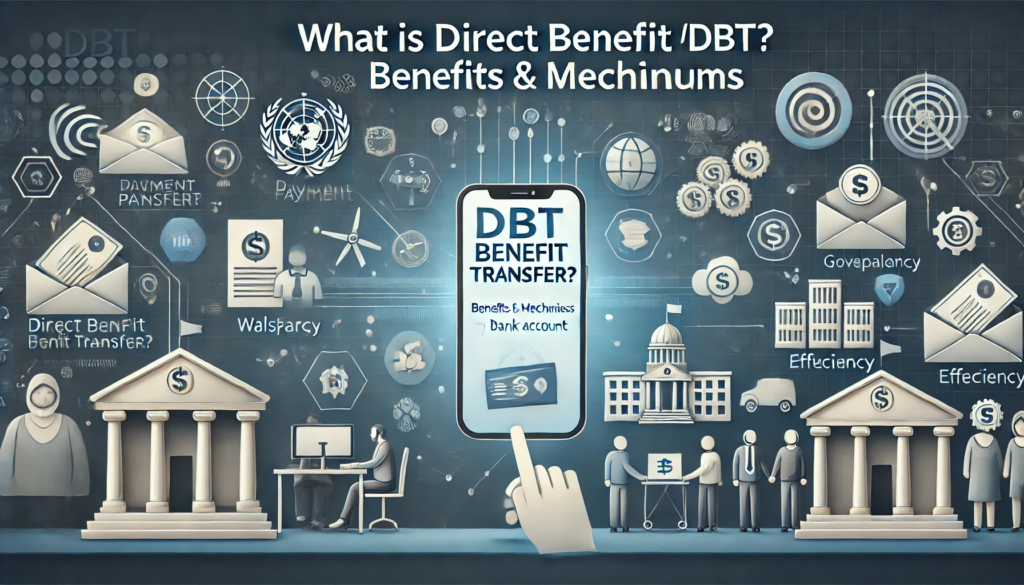Understand Direct Benefit Transfer (DBT): its benefits, challenges, and its role in transforming social and economic systems globally. Learn how DBT fosters inclusion.
Understanding Direct Benefit Transfer (DBT): Mechanisms, Benefits, and Future Prospects
Direct Benefit Transfer (DBT) represents a transformational approach to welfare service delivery. By leveraging technology, DBT seeks to directly transfer subsidies or benefits into the bank accounts of eligible beneficiaries. This model eliminates intermediaries, reducing leakages, and improving transparency in public welfare programmes.
Over the last decade, DBT has emerged as a critical mechanism for financial inclusion and socio-economic empowerment. This blog explores the inner workings of DBT, its advantages, challenges, and its role in good governance and economic growth, offering a detailed understanding of its evolution and significance.
What is Direct Benefit Transfer (DBT)?
Definition and Evolution
Direct Benefit Transfer involves transferring subsidies, pensions, scholarships, or other government-sanctioned benefits directly to eligible recipients. The concept relies on implementing technology-driven frameworks such as bank accounts linked with unique identification systems, ensuring benefits are credited securely to the beneficiaries.
The roots of DBT can be traced back to initiatives prioritising reducing corruption in public distribution systems. Countries such as India spearheaded the DBT model, particularly after the creation of technological ecosystems like the Aadhaar (a unique biometric ID). Over the years, many governments worldwide adopted this digital reform in their welfare strategies, setting new benchmarks in transparency and efficiency.
How Does DBT Work?
Mechanisms of DBT Across Sectors
DBT operates through a streamlined process leveraging robust infrastructure comprising identification systems, financial institutions, and technology platforms. Below are its key components across various sectors:
- Authentication of Beneficiaries
Databases, such as biometric IDs or social registers, verify the beneficiaries’ identities. This ensures benefits reach only those eligible for the programme, reducing fraud.
- Bank Account Integration
Government welfare databases are mapped to beneficiaries’ bank accounts. Funds are directly deposited into these accounts once eligibility is confirmed.
- Electronic Fund Transfers (EFTs)
Advanced electronic payment gateways ensure instant fund disbursal, minimising delays while maintaining exceptional traceability for transactions.
- Automation of Approvals
Automated systems, governed by configured algorithms, periodically audit and validate beneficiary details, eliminating manual intervention.
Applications of DBT span numerous social schemes:
- Agricultural Subsidies
Farmers receive fertiliser or seed subsidies directly, bypassing middlemen.
- Health Benefits
Patients relying on government health initiatives receive reimbursements directly into their accounts.
- Education Welfare
Scholarships and grants help students pay tuition fees.
Benefits of Direct Benefit Transfer
For the Government
- Transparency in Welfare Distribution
Eliminates intermediaries, reducing the scope for corruption and exploitation.
- Cost Efficiency
Lower administrative costs by automating benefit disbursal processes.
For Beneficiaries
- Prompt Disbursement
Funds reach recipients promptly without delays caused by intermediaries.
- Reduced Exploitation
Beneficiaries avoid dependency on middlemen, allowing for complete entitlement utilisation.
For the Economy
- Economic Inclusion
Encourages unbanked populations to adopt formal banking channels.
- Improved Resource Allocation
Governments are better positioned to allocate and optimise subsidies.
Challenges in Implementing DBT
Identifying Roadblocks
- Digital Divide
Many rural areas lack internet connectivity and sufficient technology penetration.
- Exclusion Errors
Errors in beneficiary databases may exclude eligible individuals.
- Banking Infrastructure Limitations
Insufficient banking facilities in remote areas slow integration.
Addressing Challenges
- Robust Infrastructure Investments
Prioritising expanding connectivity and banking infrastructure to underserved regions.
- Data Cleansing Initiatives
Conducting periodic audits of beneficiary databases to reduce exclusion/inclusion errors.
- Capacity Building Mechanisms
Training local administrators and beneficiaries to operate within DBT frameworks.
Case Studies
India’s Aadhaar-Enabled DBT System
India’s implementation of DBT stands out globally. Combining Aadhaar numbers (biometric-based unique identification) with account verifications transformed delivery systems for subsidies like LPG cylinders, scholarships, and rural employment wages.
Brazil’s Bolsa Família Programme
Bolsa Família provides cash transfers to low-income youth and families. Integrated databases ensure precision in targeting recipients, reducing poverty significantly.
The Future of Direct Benefit Transfers
Emerging Trends
- Integration with Blockchain
Blockchain helps secure databases, preventing tampering or fraudulent activity during disbursement.
- Use of Smart Contracts
Payments governed by smart contracts ensure benefits release only if set conditions are met.
- Digital Wallets and Mobile Banking
Mobile wallets simplify access for populations without fixed bank accounts.
Global Impacts
AI-based predictive analytics will identify efficiency gaps, while technological modularity creates scalable DBT solutions usable by developing or emerging economies.
DBT as a Tool for Financial Inclusion
The very premise of DBT aligns strongly with financial inclusion. Providing direct access encourages marginalised communities to participate in formal financial systems. The elimination of barriers like illiteracy, distance, and dependencies has enabled millions to access opportunities for dignified socio-economic empowerment.
Through targeted subsidy allocation, low-income populations gain financial security, facilitating sustainable development.
Best Practices for Implementing DBT
- Transparent Ecosystems
Foster transparency by sharing implementation updates with stakeholders.
- Interoperable Systems Infrastructure
Adopt interoperable software, ensuring seamless integration between databases and banks.
- Monitoring and Evaluation Frameworks
Continuous evaluations allow policymakers to refine implementation strategies for DBT.
A Path to Good Governance
Direct Benefit Transfer illustrates precision in policymaking and implementation, ensuring public welfare systems achieve tangible outcomes. Its multifunctional benefits—empowering individuals, improving economic efficiency, and safeguarding transparency—make DBT indispensable in the governance and development paradigm.
Enterprises and governments keen on leveraging DBT solutions must invest in robust digital frameworks and prioritise financial inclusion measures. With careful planning and commitment, DBT heralds a brighter, more inclusive socio-economic future


